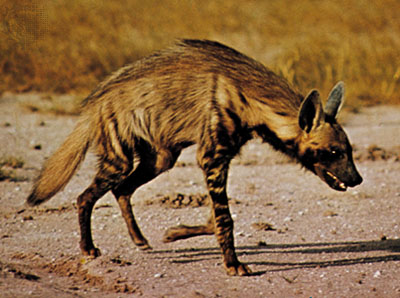The Chambered Nautilus is practically a living fossil. Many species of nautilus are extinct, with only a few surviving today. This creature has lived unchanged for millions of years. The nautilus is a mollusk and part of the Cephalopod family along with the octopi, cuttlefish, and squid. Similar to it's relatives the nautilus swims by jet propulsion and can reach a speed of up to 2 knots. It also uses siphons to propel water to escape danger.
The nautilus spends most of it's time in deep water (usually about 500-600m), but will move to shallower water during the night to feed among coral reefs. Since it is found in deep water most of the time it's eyes, unlike it's brethren, are under developed. They lack lenses, so they see the equivalent of what we see through a pin-hole camera. Because it's eyes are poor, it relies on smell and chemical sensors in it's tentacles to search out it's prey.
The Common, or Greater Potoo is part of the frogmouth, nightjar and nighthawk family. These birds are well adapted for flying and, in fact, cannot walk or hop. They spend their days roosting, mimicking tree branches and their nights darting after prey. These birds are nocturnal and feed mostly on flying insects.
Their bodies are quite round, and their heads and eyes are very large. The most unique and distinguishing factor however, is their extremely wide, gaping mouths. These mouths must be wide to capture insects as they dive out of trees. The potoo's tail and wings are also adapted for their lifestyle, they're long and wide, enabling them to maneuver after their prey.
These animals can reach a length of 13-15 inches and weigh around 5-7 ounces. They are cryptically colored and between their camouflage and stock-still pose, they are hard to distinguish from the tree branches they use as perches.
This New Zealand animal resembles a lizard but is actually considered a separate order. What makes it interesting is the fact that it has a "third eye" on the top of it's head. The use of this eye-derived spot is unknown, but there are theories concerning it's use as a thermoregulating agent and for vitamin D absorption.
There are only two species of tuataras worldwide. Measuring up to 23 inches in length and weighing up to 3 pounds the tuatara spends alot of it's time basking and is mostly nocturnal. They are insectivorous but may prey on small lizards and bird eggs when available. Their coloration varies from dark greens and browns to light. On males, a distinctive crest, for which the reptile is named, can be seen.
The aardwolf or Proteles Cristata is not related to the aardvark but to the hyena. It's name comes from the Dutch/Afrikaan words for "Earth" and "Wolf". Aardwolves are small compared to their relatives, weighing in at 50-60 pounds and standing only 15-20 inches at the shoulder.
This animal is an insectivore, meaning that it's main source of food is insects (mostly termites). This fact distinguishes it from its brethren who are mainly carnivore's. The aardwolf's tongue is long and sticky enabling it to catch termites from their mounds. The aardwolves inhabit the scrub land and plains of Southern and Western Africa. This is the only habitat in which it can thrive because the plains are where to termite mounds are located.
.jpg/300px-Nautilus_pompilius_(head).jpg)


